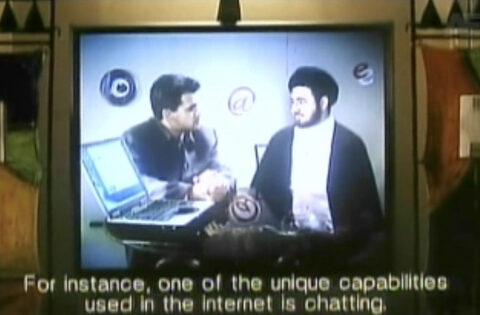Gozar, Taqlid, and Governmentality
The first time the audience is exposed to passing is when Reza enters the prison’s prayer room and learns from the other prisoners that he does not need to be religious; he just needs to know how to pray properly to appease the prison guards as a coping mechanism for being disciplined. The film implicitly alludes to the centrality of appearance and performance as modern sites of citizenship, gender identity, inclusion, and exclusion. Indeed, taqiyyah, meaning concealment or dissimulation of one’s belief, 1 has a long history in Islamic minority/majority relations. In Iranian culture taqiyyah has become an important strategic tool to justify religious, cultural, and political performance. This idea has also been combined with another concept, that of using a kola share or a jurisprudence hat, which would justify transgression from the rule of law (Islamic Sharia) through the reference to religious jurisprudence. Anyone can put this hat on while trying to justify his/her unlawful acts of transgression with the rule of law. These concepts have consistently created a flexible and ambiguous situation where one can negotiate the rule of law, or a space where the rule of law can be stretched and revised. However, the distinction between the performer and the believer has made Iranians more culturally aware of the gap between what is said and what is done in practice. The testing of this gap has been crucial in the Iranian political sphere and the politics of citizenship.
The plot develops when Reza Marmoulak steals the clergyman’s garb and turban and escapes the hospital by passing as an Imam, an akhund or mullah. The body of the new character becomes a surface on which the boundaries of masculinity and respectability can be both regulated and transgressed. While Reza’s beard, along with his garb and turban, immediately gives him the appearance of an akhund, his lack of knowledge of the rituals, especially in performing namaz-e jama’at (prayer in the company of others as opposed to solitary namaaz), puts his disguise in jeopardy. When a group of travelling men ask Reza to perform a namaz-e jama’at at the prayer house of the train station, Reza manages to conceal his lack of knowledge by mimicking vudu (the preparation for the prayer, including the ritual of washing the face, hands, and feet before prayer) and by making up words that sounded like prayer.
The film goes beyond the dichotomy of tradition and modernity by depicting religion not as the opposite of modernity and progress, but well integrated within the modern nation-state. In addition to the visual representation of trains, taxis, TVs, and telephones, a conversation between Reza and his smuggler friend to arrange for a fake passport to allow him to leave Iran reveals the influence of new media technologies and transnational film industry. In this scene, the audience is exposed to a discussion on one of the public TV channels between a religious figure and a show host on the capabilities of the Internet. Reza repeats the words—Internet, chat, and multimedia—to mimic words that he thinks are used by religious people. His friend advises him to not listen to that particular akhund and try to instead mimic the real clergymen who do not speak in those terms. In response, Reza changes the channel and another clergyman appears, this time discussing the movie Pulp Fiction.

The film depicts religious spaces as integrated in the urban landscape, as seen in the prayer house at the train station and the mosque in the middle of a neighborhood. What divides the space are class and gender relations. The religious space mediates different classes to a limited extent. To reach out to the poor, the film offers two options: either the mosque becomes more receptive to marginalized classes, or the Imam should visit the poor in their homes. Reza takes up both by making the mosque more receptive to a diverse group of people and using the justification of visiting the poor at their homes to connect with the smugglers.
Passing could be translated as gozar in Farsi, and McClintock describes it as the “masking of ambiguity: difference as identity.” 2 As Linda Schlossberg notes, passing is a highly charged site for anxieties regarding visibility, invisibility, classification, and social demarcation, and for the creation and establishment of an alternative set of narratives or a novel way of creating new stories out of unstable ones. 3 Passing also refers to the transgression of boundaries of highly stigmatized identities 4 and the strategic use of identity. 5 Passing should be understood in relation to similar concepts such as mimicry (taqlid) and ambivalence (doganegi). In his discussion of colonial mimicry, Homi Bhabha refers to the discourse of mimicry as “the desire for a reformed, recognizable Other, as a subject of a difference that is almost the same, but not quite. Which is to say, the discourse of mimicry is constructed around an ambivalence; in order to be effective, mimicry must continuously produce its slippage, its excess, its difference.” 6 In the case of Marmoulak, more than anything else, passing provides space for the sexualized masculinity of the criminal and the outlaw to not only be seen, but heard as well. I argue that passing, mimicry, and ambivalence are not limited to the colonial context, but also expose problems of normativity and criminality that are at the core of modern disciplinary regimes of knowledge and power in the context of both colonial and postcolonial formations. I employ the concept of passing by broadening it and taking it into the context of political and cultural citizenship. Passing and mimicry in this context continue to create space for what Bhabha calls “at once resemblance and menace” 7 given the continuous reliance of postcolonial nation-states on discourses of normativity and respectability, as well as gendered subjects.
To perform respectability through masculinity, the film shows how a religious act is achieved through the display of an ethical and disciplined subject position who leads a virtuous life by resisting temptation. Here, the pious masculinity of the clergyman converges with the secular masculinity of the citizen as they are both subjected to the rule of law and the disciplinary order of the nation-state (both secular and religious). The abstract ethic of either a pious or secular masculinity is transgressed by the hyper-masculinity of Reza, who follows mundane pleasures along with a situated notion of what is just or unjust through a perverse and forbidden exercise of power. For example, when Reza takes the train to a border city, a mother and daughter share a cabin with him. To his pleasure, once Reza settles into the cabin the mother confides in him about her daughter’s marriage problems. However, as soon as the mother falls sleep, Reza starts flirting with the daughter.
Here language leads to Reza’s most challenging moment of mimicry when he struggles to transform his flirtatious and sexualized thoughts into the language of sympathy and compassion. The film shows how the mediation of proper language is the pre-condition for entrance of the subject into the world of normative masculinity. Also, his position as a respectable clergyman becomes a limit to his desire to share the train cabin with the two women; to Reza’s great regret and in spite of his insistence on the women staying, a fellow traveler moves the women to another cabin to give Reza more space. It should be noted that while the film challenges notions of criminality and respectability in both secular and religious discourses through an interrogation of the pious masculinity of the Islamic clergyman and the sexualized hyper-masculinity of the thief, it does not question heteronormative citizenship. Instead, the film reinforces heteronormativity by constructing the sexualized masculinity of the thief as heteroerotic. 8
In the context of Iran, where there is a close link between the embodied performance of identity, the politics of appearance, and dress code in the formation of gendered notions of citizenship, an investment in visual and visible modes of representation is crucial for issues of governmentality. I refer to governmentality in its Foucauldian sense to talk about technologies of domination of others and those of the self. As I have argued elsewhere, the regulation of citizenship through visual media has been critical for both the project of modernization and modern nation-state building in Iran, as well as for the establishment of an Islamic state. The performance of religiosity and secularism, masculinity and femininity, and modern and traditional has been an integral part of these forms of embodied citizenship. 9 For example, the instance of forced unveiling or veiling as a site of performance of modern forms of gendered citizenship is a good illustration of this situation. 10 The concept of imitation or taqlid is not foreign to Shia Islam because of the legitimacy of practicing taqlid to follow a religious leader in legal and spiritual matters. The use of garb and appearance in the film not only makes the body a surface for mimicry and imitation, but also legitimizes the authority of the passing subject to perform religious practices.
Passing is specifically significant in Iranian movies given the importance of filmic space as an alternative site for cultural struggle, and it has facilitated critical reflection on social issues. Information technologies have become an important part of what Foucault calls “the art of government,” especially in regulating both discipline and sovereignty. 11 In other words, governmentality refers to the connection between power as the regulation of others and as a relationship with oneself, linking ethics and politics. Indeed, the regulation of citizen-subjects through visual mediums has been central to regimes of modern and postmodern governmentality and cultural citizenship.
Through passing, Reza Marmoulak’s character deconstructs rigid dichotomies and binaries that have long influenced modern Iranian political discourses. The film also transgresses the boundaries of secular and religious, sacred and popular, modern and traditional, and pious and criminal by juxtaposing and converging linguistic and performative disciplinary practices. While passing does not deconstruct subject positions or gendered and religious citizenship, it does provide space for a critique of what stabilizes meaning and the body historically, enabling the intervention of the investigating subject of passing by unsettling modern notions of both respectability and criminality.
- The word al-taqiyya literally means “concealing or disguising one’s beliefs, convictions, ideas, feelings, opinions, and/or strategies at a time of eminent danger, whether now or later in time, to save oneself from physical and/or mental injury.” A one-word translation would be “dissimulation” (from A Shi’ite Encyclopedia, Chapter 6.b, Version 1.5: www.al-islam.org/encyclopedia/chapter6b/1.html.[↑]
- McClintock, 1995, 65.[↑]
- Schlossberg, 1-4.[↑]
- Goffman, 1963.[↑]
- For an astute analysis of Goffman’s views on passing and everyday negotiations, see Daniel G. Renfrow, 2004.[↑]
- Bhabha, 1994, 86.[↑]
- Ibid.[↑]
- For an insightful analysis of heteronormative citizenship and the politics of passing, see Carol Johnson, 2002.[↑]
- Parama Roy argues that in the colonial context, citizenship, and nation-ness are generated and consolidated by an endless circuit of exchange and impersonation between Anglo-Indian and other Indian men (1998, 88). I would add that indeed this circuit continues in the context of the nation-state between respectable and criminal men.[↑]
- For an analysis of gendered citizenship in the context of pre- and post-revolutionary Iran, see Moallem, 2005. For a historical analysis of gender formations in Iran, see Najmabadi, 2005.[↑]
- According to Foucault, the art of government strives for the essential continuity between the art of self-government, the art of properly governing a family, and the science of ruling the state (1994, 206).[↑]



